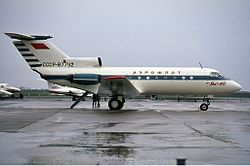Hijacking
Ten minutes prior to landing at Bryansk Airport, four male hijackers (Viktor Romanov, Vladimir Zhalnin, Pyotr Bondarev, and Aleksandr Nikiforov) retrieved guns out of the overhead luggage bins and took passengers as hostages, then attempted to storm the cockpit. The noises from the passenger cabin reached the cockpit. [4] Captain Kashin asked his flight engineer to investigate the situation in the cabin, and after Nikitin realised that there were hijackers on board, he immediately shouted the information to the flight crew and shut the door from the outside. The flight engineer tried to defuse one of the hijackers (Romanov), however, he was injured by Zhalnin. [5] One of the passengers (Vladimir Gaponenko) attempted to defuse Bondarev, but he lost his balance from the aircraft pitching, and as a result got injured.
In the flight deck Kashin sent a distress signal to air traffic control. Meanwhile, the attackers managed to break the lock on the cockpit door and entered the flight deck. Hijackers demanded the flight crew head back to Moscow. Whilst on approach to Vnukovo Airport, the intruders forced the crew to inform the authorities that they demanded payment of US$1.5 million for all hostages and for information about future aircraft hijacker groups. Despite difficult weather conditions in Moscow, the crew managed to successfully land the Yak-40 at Vnukovo.
On the ground
KGB Chairman (and future leader of the USSR) Yuri Andropov and the Minister of Internal Affairs Nikolai Shchelokov soon arrived at the airport and began developing a strategy to free the hostages.
Hijackers let two injured hostages (Nikitin and Gaponenko) out of the plane. Then, the hijackers put forward extra conditions: the authorities must let them refuel the aircraft and give them half of the buyout (or ransom) in return for half of the hostages. The intruders plan was to fly to Leningrad, where they would let the rest of the hostages out and refuel the Yak-40, enough for them to fly to Sweden. Nevertheless, it was decided to not let the captured aeroplane out of Moscow, and instead storm the aircraft. A storming group of volunteer policemen (Mikhail Lyakhmanov, Vladimir Rakov, Aleksandr Mushkarin, Nikolai Kapustin and Aleksandr Popryadukhin) was put together by the authorities. This group secretly sneaked towards the plane and hid under it next to the front landing gear. After several hours of waiting the intruders were informed that the authorities were ready to transfer the money. At first, a suitcase full of fake banknotes was supposed to be carried by a KGB officer, but at the last minute he refused to do it, so a transport police officer carried it instead.
After hijackers heard movements under the Yakovlev Yak-40, they assumed that the buyout was finally delivered. One of the hijackers (Nikiforov) opened the door, then sergeant Rakov pressed a pike pole against the door. Hijacker Zhalnin began shooting at the police officers, who retaliated. As a result, Nikiforov fell onto the airfield, sustaining serious injuries (from which he later died in hospital). At the same time, an armoured personnel carrier approached the aircraft and fired a line from the machine gun aiming at the plane, which suffered around 90 bullet hits. Tear gas was then used; however, the smoke bomb got stuck between the seats, which caused the upholstery to burn. As the smoke flocked the cabin, panic arose amongst the passengers, who started to escape the aircraft. Hijackers Bondarev and Zhalnin escaped the plane together with the passengers, whilst Romanov shot himself. As a result of storming the aircraft two passengers were injured, but none died.
